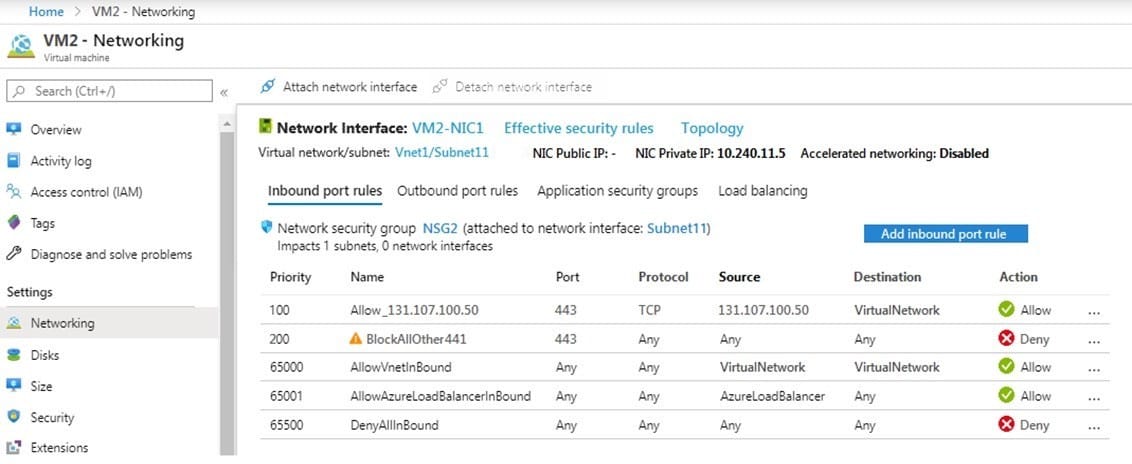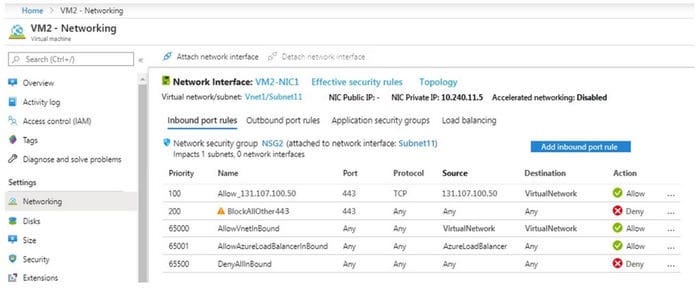Exam Details
Exam Code
:AZ-104Exam Name
:Microsoft Azure AdministratorCertification
:Microsoft CertificationsVendor
:MicrosoftTotal Questions
:361 Q&AsLast Updated
:Apr 16, 2025
Microsoft Microsoft Certifications AZ-104 Questions & Answers
-
Question 311:
You need to create an Azure virtual machine named VM1 that requires a static private IP address configured inside the IP address space for the VNet in which the VM resides. How do you configure a static IP address for this Azure VM?
A. After the VM has been created, create a new network interface and configure a static IP address for that network interface
B. When creating a VM in the portal, select New next to private ip address and choose static after assigning the correct IP address
C. When creating the VM in the portal, change the setting from dynamic to static on the networking tab under private IP address
D. After the VM has been created, go to the network interface attached to the VM and change the IP configuration to static assignment
-
Question 312:
You have an Azure subscription. You need to transfer 34TB of data from an on-premise Windows 2016 server to your Azure storage account. You need to ensure that the data transfer has zero impact on the network, preserves your existing drives and is the fastest and most secure method.
What should be your first step?
A. Start an Import Job via the Azure Portal
B. Order an Azure Databox via the Azure Portal
C. Open a ticket with Microsoft Support
D. Prepare your hard drives using the WAImportExport tool
-
Question 313:
You manage a virtual network named VNet1 that is hosted in the West US region. Two virtual machines named VM1 and VM2, both running Windows Server, are on VNet1. You need to monitor traffic between VM1 and VM2 for a period of
five hours.
As a solution, you propose to create a connection monitor in Azure Network Watcher.
Does this solution meet the goal?
A. Yes
B. No
-
Question 314:
You have an Azure DNS zone named adatum.com.
You need to delegate a subdomain named research.adatum.com to a different DNS server in Azure.
What should you do?
A. Create an NS record named research in the adatum.com zone.
B. Create an PTR record named research in the adatum.com zone.
C. Modify the SOA record of adatum.com.
D. Create an A record named *.research in the adatum.com zone.
-
Question 315:
You have an Azure subscription.
You plan to deploy an Azure Kubernetes Service (AKS) cluster to support an app named App1. On- premises clients connect to App1 by using the IP address of the pod.
For the AKS cluster, you need to choose a network type that will support App1.
What should you choose?
A. kubenet
B. Azure Container Networking Interface (CNI)
C. Hybrid Connection endpoints
D. Azure Private Link
-
Question 316:
Note: This question is part of a series of questions that present the same scenario. Each question in the series contains a unique solution that might meet the stated goals. Some question sets might have more than one correct solution, while
others might not have a correct solution.
After you answer a question in this section, you will NOT be able to return to it. As a result, these questions will not appear in the review screen.
You have an Azure subscription that contains the virtual machines shown in the following table.

You deploy a load balancer that has the following configurations:
1.
Name: LB1
2.
Type: Internal
3.
SKU: Standard
4.
Virtual network: VNET1
You need to ensure that you can add VM1 and VM2 to the backend pool of LB1. Solution: You disassociate the public IP address from the network interface of VM2. Does this meet the goal?
A. Yes
B. No
-
Question 317:
Note: This question is part of a series of questions that present the same scenario. Each question in the series contains a unique solution that might meet the stated goals. Some question sets might have more than one correct solution, while
others might not have a correct solution.
After you answer a question in this section, you will NOT be able to return to it. As a result, these questions will not appear in the review screen.
You have an app named App1 that is installed on two Azure virtual machines named VM1 and VM2. Connections to App1 are managed by using an Azure Load Balancer.
The effective network security configurations for VM2 are shown in the following exhibit.

You discover that connections to App1 from 131.107.100.50 over TCP port 443 fail.
You verify that the Load Balancer rules are configured correctly.
You need to ensure that connections to App1 can be established successfully from 131.107.100.50 over TCP port 443.
Solution: You modify the priority of the Allow_131.107.100.50 inbound security rule.
Does this meet the goal?
A. Yes
B. No
-
Question 318:
Note: This question is part of a series of questions that present the same scenario. Each question in the series contains a unique solution that might meet the stated goals. Some question sets might have more than one correct solution, while
others might not have a correct solution.
After you answer a question in this section, you will NOT be able to return to it. As a result, these questions will not appear in the review screen.
You have an app named App1 that is installed on two Azure virtual machines named VM1 and VM2. Connections to App1 are managed by using an Azure Load Balancer.
The effective network security configurations for VM2 are shown in the following exhibit.

You discover that connections to App1 from 131.107.100.50 over TCP port 443 fail.
You verify that the Load Balancer rules are configured correctly.
You need to ensure that connections to App1 can be established successfully from 131.107.100.50 over TCP port 443.
Solution: You delete the BlockAllOther443 inbound security rule.
Does this meet the goal?
A. Yes
B. No
-
Question 319:
Note: This question is part of a series of questions that present the same scenario. Each question in the series contains a unique solution that might meet the stated goals. Some question sets might have more than one correct solution, while
others might not have a correct solution.
After you answer a question in this section, you will NOT be able to return to it. As a result, these questions will not appear in the review screen.
You have an app named App1 that is installed on two Azure virtual machines named VM1 and VM2. Connections to App1 are managed by using an Azure Load Balancer.
The effective network security configurations for VM2 are shown in the following exhibit.

You discover that connections to App1 from 131.107.100.50 over TCP port 443 fail.
You verify that the Load Balancer rules are configured correctly.
You need to ensure that connections to App1 can be established successfully from 131.107.100.50 over TCP port 443.
Solution: You create an inbound security rule that denies all traffic from the 131.107.100.50 source and has a cost of 64999.
Does this meet the goal?
A. Yes
B. No
-
Question 320:
You have an Azure subscription that contains the identities shown in the following table.

User1, Principal1, and Group1 are assigned the Monitoring Reader role.
An action group named AG1 has the Email Azure Resource Manager Role notification type and is configured to email the Monitoring Reader role.
You create an alert rule named Alert1 that uses AG1.
You need to identity who will receive an email notification when Alert1 is triggered.
Who should you identify?
A. User1 and Principal1 only
B. User1, User2, Principal1, and Principal2
C. User1 only
D. User1 and User2 only
Related Exams:
62-193
Technology Literacy for Educators70-243
Administering and Deploying System Center 2012 Configuration Manager70-355
Universal Windows Platform – App Data, Services, and Coding Patterns77-420
Excel 201377-427
Excel 2013 Expert Part One77-725
Word 2016 Core Document Creation, Collaboration and Communication77-726
Word 2016 Expert Creating Documents for Effective Communication77-727
Excel 2016 Core Data Analysis, Manipulation, and Presentation77-728
Excel 2016 Expert: Interpreting Data for Insights77-731
Outlook 2016 Core Communication, Collaboration and Email Skills
Tips on How to Prepare for the Exams
Nowadays, the certification exams become more and more important and required by more and more enterprises when applying for a job. But how to prepare for the exam effectively? How to prepare for the exam in a short time with less efforts? How to get a ideal result and how to find the most reliable resources? Here on Vcedump.com, you will find all the answers. Vcedump.com provide not only Microsoft exam questions, answers and explanations but also complete assistance on your exam preparation and certification application. If you are confused on your AZ-104 exam preparations and Microsoft certification application, do not hesitate to visit our Vcedump.com to find your solutions here.